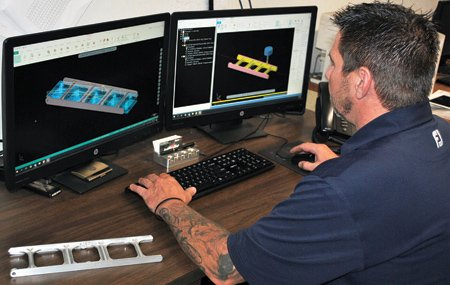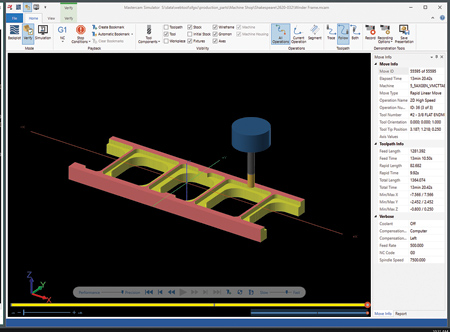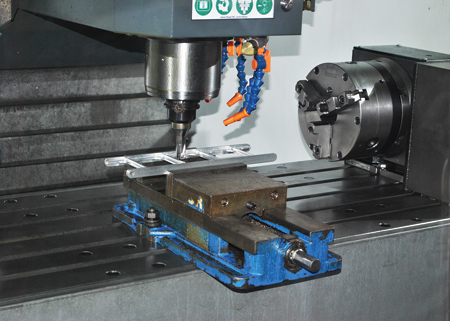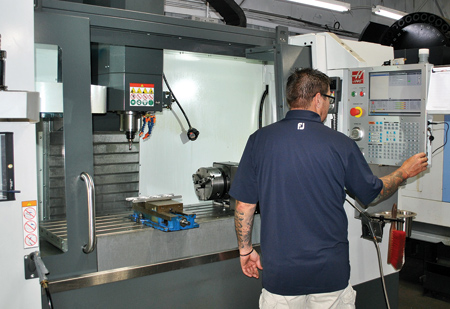
Greg Williams, Stainless Fittings Group (SFG) CNC Supervisor, programs a winder frame part using Mastercam's 2D Dynamic Rough toolpath. The part was finished with the 3D High Speed Waterline toolpath.

SFG winder frame part programmed with Mastercam's 2D Dynamic Rough. Finished using Mastercam 3D High Speed Waterline toolpath.

SFG winder frame part being verified through Mastercam before machining.

An SFG winder frame part is machined out of 6061-T6 aluminum using Mastercam Dynamic toolpaths.

Greg Williams, Stainless Fittings Group (SFG) CNC Supervisor, uses Mastercam Dynamic toolpaths to machine a winder frame part on a Hass VF-4 vertical mill.
Stainless Fittings Group (SFG) is a mom-and-pop machine shop that became a division of Texas Pipe & Supply (Houston, TX) a few years ago. But that has not changed things much.
"We still run like we always have, but now we have the backing of a larger corporation," said Greg Williams, SFG's CNC Supervisor.
Located in Traveler's Rest, SC, the company houses two completely different operations in one facility. In one half of the plant, stainless steel pipe fittings, flanges and custom fabrications are produced for several industries, including oil and gas, food and beverage, chemical, and semi-conductor. The other half houses production of precision military antenna parts for a company that provides military vehicles to the U.S. Department of Defense (DOD). The antenna parts are fully machined from stainless steel. Prior to 2015, this operation was performed without automation or aid from CAD/CAM software.
"I started here in 2015, but it was like stepping into the `80s," explained Williams. "Everything was programmed by hand from a 2D paper drawing provided by the customer, and all of the fixtures were cobbled together-sometimes from old fixtures used for other parts. They got by with what they had."
Williams came to SFG after working as a sales and tech support rep for manufacturing software reseller, Barefoot CNC (Morganton, NC), for almost five years. He was well-equipped to bring the company into the 21st century. "I have used Mastercam (CAD/CAM) software (CNC Software, LLC) for a long time, first as a machinist, then as a sales rep and doing tech support for Barefoot customers," he explained. "When I stepped in at SFG, I could see the potential for CAD/CAM right away."
First and foremost, SFG customers no longer had to take the painstaking step of creating 2D drawings of the parts they had engineered in 3D. With the introduction of Mastercam, SFG could accept solid models. This streamlined intake of new parts, as well as communication and production planning since everyone was looking at the same renderings.
As easy as that switch was with customers, internally, Williams had to prove to a fairly skeptical audience that these renderings were more than just something for planning and engineering. "For the machinists at first, the solid models were just eye candy-they looked cool, but so what?" said Williams.
But once he started creating and running toolpaths using the Mill module, everyone started to see the real potential of the CAD/CAM software.
Mastercam Mill gives machinists the ability to create, verify and optimize machining strategies specific to the parts, machines and tools they are using, and then generate the CNC toolpaths they need to run the part. Williams demonstrated how experimenting with different strategies in the software's virtual environment would lead to greater efficiencies on the shop floor, including creating better fixtures.
"The toolpath strategies that we applied eliminated multiple set-ups, increased tool life and shortened cycle times. And then we were able to produce higher quality parts. When everyone saw how CAD/CAM software helped them start work sooner and produce better parts faster, everyone got it. Then we were really off to the races," said Williams.
Making better parts faster is the goal of every manufacturer, but for small shops, efficiency is especially important. SFG runs the DOD parts on four mills and nine lathes. None of the lathes have live tooling, so being able to experiment with new toolpaths and operation strategies helped speed cycle times considerably by adjusting how much work could be done on the lathe before moving it to a mill to finish, or vice versa.
"One particular part was a 500-piece lot," said Williams. "Before, we were running it using a vise and two set-ups. The machine has a fourth axis, so right away, this did not seem right."
Using Dynamic Motion, SFG programmers were able to figure out how to create fixtures that let them simply flip the part on its side and take advantage of the fourth axis. "We went from producing 50 parts a day to more than 125," said Williams. "We only have four mills, so figuring out things like this really boosts productivity."
Mastercam's Dynamic Motion gives users the ability to consider material properties, tool properties and machine properties to create toolpaths and motions that extend tool life and reduce cycle times, which in turn, extends the life and productivity of the machine.
Williams also explained how this example exposes one of the most common productivity busters on shop floors: getting into a rut. The machinists knew that what they were doing was not the best way, but they did not have the time or extra material to experiment with something new. Using Dynamic Motion along with Verify and Backplot let them see the entire machining process virtually, allowing them to experiment with different methods and toolpaths without wasting machine time or materials. In SFG's case, the machinists were able to eliminate multiple set-ups, increase tool life and shorten cycle times significantly, all while improving part quality.
Another example Williams gave is how his team used Dynamic Rough to switch from older roughers to insert-type cutters.
"These antenna parts are stainless steel, so insert cutters really help rough and finish parts more accurately," Williams explained. "It was an expensive switch, but better tooling cut our cycle times down from 10 minutes to two minutes. Tool life is also longer, so the trade-off in the long run has been off the charts."
SFG can have 20 or more parts in production at any one time-most of them coming in smaller 100 to 1,000 lots. Improving production time and part quality for all of its parts improved the shop's overall productivity and profitability. With the added productivity and profitability of SFG's antenna parts division, management is now considering adding either a lathe with live tooling or one with dual spindles to the small shop.
"Mastercam is going to be a big part of making that machine a powerhouse in the lathe department," said Williams. "And I know the Barefoot team will provide us with whatever we need to get the lathe CAD/CAM system up and running."
While the software system has quickly become an essential tool in making better parts faster, one of the more unexpected things CAD/CAM software has become for SFG is a sales tool. Once Williams understood the new capabilities the software enabled for the company, he saw the potential to go back to the DOD's suppliers and bid on additional parts. He went back to the customer and let them know that the company had invested in technology upgrades. He explained his background and abilities and asked to bid on more complex parts.
"I think before I came on board, we may have been left out of the bidding on some of the business we are winning now," said Williams. "It is why they hired me-to make their part machining operations more profitable. Making new sales is a part of that."
For Williams, his position as CNC supervisor at SFG is the latest step in a career that has taken him from machine shop class in high school, to manual machining, to punching CNC tapes, to using (then selling) CAD/CAM software and beyond.
"There are a hundred roads you can travel in manufacturing," said Williams. "Manufacturing is not about standing there running a mill in a dirty environment. Depending on what you want to do, the opportunities are there. You can become a manufacturing engineer or the operations manager of the whole plant; it all starts in the same place. That is what I tell all the younger guys working under me-it is unlimited. Whatever you want to do, you can do it in manufacturing."
Looking back, Williams pointed out that pushing his own boundaries was a big factor in advancing his career. He was willing to learn how to punch tape and learn CAD/CAM software. "I really took a big leap when I decided to work for a reseller. But I learned it, and I enjoyed it," he said.
Williams is now passing his knowledge and work ethic on to the next generation of machinists. "I have a young guy working for me now who is learning the ropes as a machine operator," he explained. "But I have told him from day one-I am not going to teach you how to run parts. I am going to teach you how to set them up, program them and make them better."
Williams sees his protege as someone who can someday fill his shoes. "I am going to make him the best CNC machinist he can be, so when I am ready to retire, he will be ready to take over," he said.
For more information contact:
Stainless Fittings Group
P.O. Box 967
1925 Geer Hwy.
Traveler's Rest, SC 29690
864-836-7180
sales@sfgsc.com
www.sfgsc.com
CNC Software, Inc.
671 Old Post Road
Tolland, CT 06084
800-228-2877
info@mastercam.com
www.mastercam.com